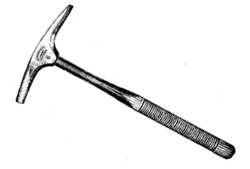Authors: Dan Lewis
Now I Know More (25 page)
Lincoln won the election and on February 22, 1861, Weston started walking. The trip took him ten days and ten hours, and the weather didn't cooperateâhe had to battle through snow, ice, and rain, making the grueling trip even less of a walk in the park. He barely slept, he ate while he walked (which was hard to do in the days before granola bars and ziplock bags), but he managed to arrive on time for the festivities in Washington. His trek drew media attention, and he became a minor celebrity. He even got to meet Lincoln; as Wikipedia notes, he received “a congratulatory handshake from the new president.”
Weston had found his calling and kept on walking. As retold by ESPN's Grantland, “In 1867, he became a household name by walking from Portland, Maine, to Chicago in 26 days, 1,200 miles along the post road. Weston was greeted by massive crowds everywhere he went; newspaper writers around the country worked themselves into a froth debating the merits of the undertaking.” His efforts, defying common sense and the elements, ushered in a nationwide interest in a new sport called “pedestrianism”âcompetitive walking.
For the remainder of the 1800s, pedestrianism continued to grow throughout the United States and even found significant popularity in Great Britain. Some races were city-to-city jaunts, at times taking weeks, but the big commercial value lay in “six-day races” at arenas such as Madison Square Garden. Matthew Algeo, author of the book
Pedestrianism
, which chronicles the sport, explained in an interview with NPR that competitors would walk around a track, typically an eighth of a mile long, from midnight Monday morning until midnight the next Saturday evening. The rules varied, but in many cases, whoever walked farthest won; at other times, the competition was to see who could last the longest without collapsing. (In all cases, competitive walkers were afforded a brief sleep break each day, but nowhere near eight hours of it.) These races attracted thousands upon thousands of fans, spectators, and gamblers, each willing to pay for a ticket and various concessions.
In the sport's heyday, Weston was a household name on both sides of the pond. He dedicated most of his life to the sport, even as its popularity waned. In 1913âthen age seventy-three or seventy-fourâWeston walked from New York City to Minneapolis in fifty-one days. The trip was more than 1,500 miles; that's thirty miles a day.
Competitive walking waned around the turn of the twentieth century. It almost entirely disappeared after the invention of the car (although the much-less-popular racewalking persisted for a time), which, in a cruel form of irony, also robbed Weston of his notable skill. In 1927, well after he retired from his now-dead sport, Weston was hit by a taxicab. He would never walk again, competitively or otherwise, and was confined to a wheelchair. He passed away two years later.
Walking can also be a job in and of itself in modern timesânotably in Tehran, Iran. Because of Tehran's traffic and pollution concerns, the government only allows cars to take to the roads on alternate daysâcars with license plates ending in odd numbers on odd-numbered days and even plates on even days. Some drivers, wanting to get around the law, hire people to walk behind their cars in the traffic-heavy areas, obscuring their license plates and helping the drivers avoid traffic tickets.

HOW TO BRING YOUR LUNCH TO WORK IN INDIA
Imagine a man on a bicycle carrying two dozen or so metallic cylindrical containers, each of which resembles a small beer keg or a transportation capsule for toxic waste. The containersâmost often made of tin or aluminumâare called
dabbas
. There are 4,500 to 5,000 dabbawalas riding around every alley and street of Mumbai, India, every day, even during monsoon season, often traveling long distances. Collectively, the dabbawalas traffic as many as 200,000 dabbas each day.
But don't worry. They're delivering lunch.
Translated literally,
dabbawala
means “box person” or “one who carries a box.” A
dabba
is a boxâin this case, a bit of a misnomer because the “boxes” used are clearly cylindersâwhile
wala
is a suffix for one who does something with the item. In this sense, a dabbawala is simply a food delivery guy, which sounds like a rather pedestrian (pardon the unintentional reverse pun) occupation. But in Mumbai, being a dabbawala isn't just a jobâit's a skilled trade all to itself. And a highly successful one at that.
The dabbawala trade began in the mid-to-late 1800s during the British Raj, the British rule of India. Many Britons who came to India did not enjoy the local cuisine and wanted to eat a more familiar lunch (called “tiffin”) at work. However, their offices did not have kitchens, and carrying a lunch was either too cumbersome or beneath the generally aristocratic colonial rulers. It became necessary to transport lunches from the homes of British colonists to their places of work, and a cottage industry cropped up. By 1890, a 100-person delivery company was running much of the lunch delivery business in the area, and over the course of the next half-century or so, the dabbawala industry formed a union, now known as the Nutan Mumbai Tiffin Box Suppliers Trust. Today, although the British Raj is long gone, the business is still growing; in 2007, the
New York Times
reported that the dabbawala industry was increasing at 5â10 percent annually.
Why is business so good? Mumbai's traffic can be nightmarishly bad, making the trip from suburbs to city by car unworkable for most people. Taking the train is a better option, but that makes it difficult to carry items, and the commute is so long that lunch would have to be prepared the night before. A small but meaningful percentage of Mumbai office workers choose to let the network of dabbawalas handle the lunch part. Each day, one delivery person picks up lunch later in the morning, bicycles it and others along its route to the train, and another dabbawala transports the lunch the rest of the way. For 450 rupees per monthâthat's about $8.25âworkers can get their home-cooked meals brought to them with nearly 100 percent reliability.
Yes, nearly 100 percent. The dabbawalas, who are often illiterate, navigate the roadways of Mumbai with incredible efficiency. As the
Guardian
noted, “
Forbes
awarded the humble dabba-wallahs [
sic
] a 6 Sigma performance rating, a term used in quality assurance if the percentage of correctness is 99.9999999 or more. In other words, for every six million tiffins delivered, only one fails to arrive. This error rate means in effect that a tiffin goes astray only once every two months.” In 2011, when the team from the television show
Top Gear
tried to beat a dabbawala delivery service by using a car instead of the train, they failed miserably.
The dabbawalas themselves earn 8,000 to 10,000 rupees per month (roughly $150â$175), or about 100,000â120,000 rupees annually. This is much higher than the per-capita income in Indiaâabout 53,333 rupees (about $975) per yearâbut that's not enough, many claim. Due to the higher cost of living in the Mumbai area, combined with recent upticks in inflation, the dabbawala union recently requested taxi-operator permits for 2,000 of its 5,000 members.
If Guy de Maupassant, a famous nineteenth-century French writer, wanted his lunch delivered by dabbawala (leaving aside that there are none in Paris, certainly not when Maupassant was alive), he would have had them deliver the cooked meals to the base of Paris's Eiffel Tower. Not because he liked the food at the Tower's restaurant. The Tower, completed in 1889, was not immediately well received by many, and especially not Maupassant. As the
New York Times
noted, Maupassant “saw the tower as an affront to his nation's proud cultural heritage and dined regularly in its restaurant because that was the one spot in Paris from which he didn't have to look upon âthis giant and disgraceful skeleton.'”

THE THRONE THAT COMES WITH A LICENSE TO MARRY
The requirements for obtaining a marriage license in the state of New York are rather boring. Each person has to be at least eighteen years old or have parental consent (and in no case will the state issue a marriage license to someone under the age of fourteen). Certain close relatives can't marry, and people who are currently married to other people are similarly ineligible to marry someone else. You have to fork over $40. But it's pretty straightforward, as you'd expect. By requiring that the grooms first send in a picture of their commode before issuing a marriage license, the government is incentivizing the start of a cultural change via infrastructure improvements.
But to participate in a particular marriage ceremony in the Madhya Pradesh, a state in India, you need to prove something else. The groom needs to show that his domicile comes with a toilet.
Really.
In early 2013, Madhya Pradesh officials conducted a mass marriage ceremony to provide a way for women from poor families to wed their would-be grooms. It's a program that has been around since 2006 or 2007. The recent ceremony attracted just under 200 couples to the proverbial (but in this case, nonexistent) altar, and the program has seen nearly 2,000 poor couples enter into marriage this way in about a year's time. And the state is using it as an opportunity to fix another problem.
According to the World Toilet Organizationâyes, there's a World Toilet Organization (and it's actually a pretty serious charity)âthere are about 2.5 billion people without access to a functioning private toilet. Most of them live in developing regions and are very poor, and the fledgling families in Madhya Pradesh are no exception. A recent survey suggests that half of all Indian households lack a toilet, which is a major public health issue. As
Fast Company
points out, improperly disposed-of fecal matter is the largest killer of children across the world, claiming over 1.4 million young lives a year. According to a 2007 report by Bloomberg, India accumulates as much as 100,000 tons of human excrement in fields each day.
So far, we don't know whether the toilets-for-marriage-licenses program will have an effect on the problem. But the problem is significant enough to warrant this otherwise absurd-sounding requirement.
Ghana is looking at another way of dealing with the same problem, but their solution doesn't involve marriage. It involves recycling. According to
GOOD
, “fecal sludge” (their words) may be able to be used as an industrial fuelâbasically, a (rather gross) biodiesel. The theory is, if that happens, markets will form to purchase the sludge before it becomes an everyday pollutant, thereby creating the financial incentive necessary to prevent haphazard dumping of latrines. The initiative has serious support behind itâit is backed by the Bill and Melinda Gates Foundation.

HOW FAR CAN YOU GO WITH A HAMMER, CHISEL, AND SOME NAILS?
In 1992, Canadian singer Celine Dion released a single titled “Love Can Move Mountains.” The song, which peaked at #36 on the
Billboard
U.S. Hot 100 chart and at #8 overall on Canada's equivalent, probably should not have its title taken literally. But no one bothered to tell that to an Indian laborer named Dashrath Manjhi.

